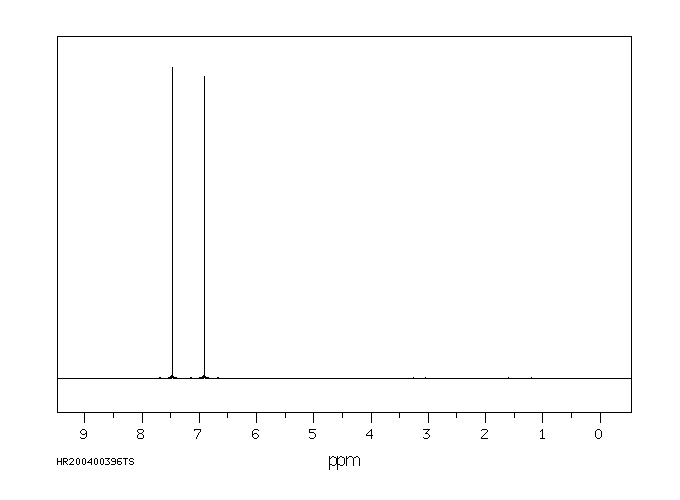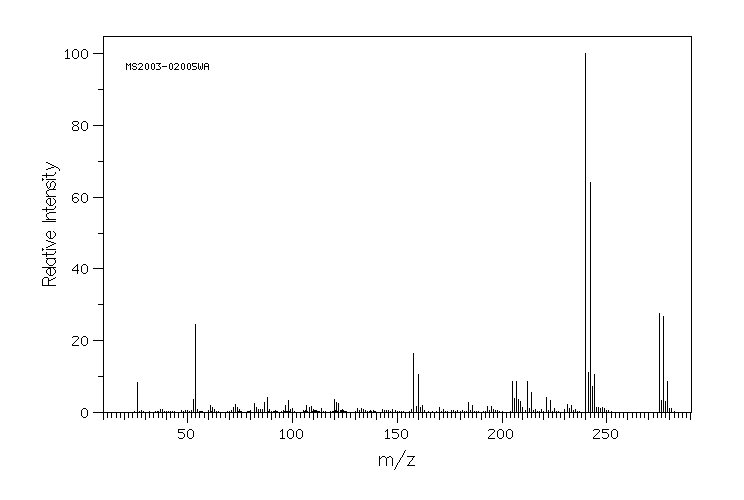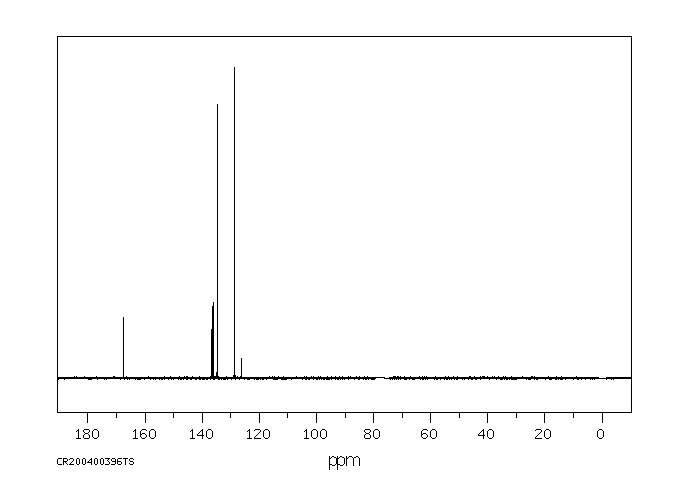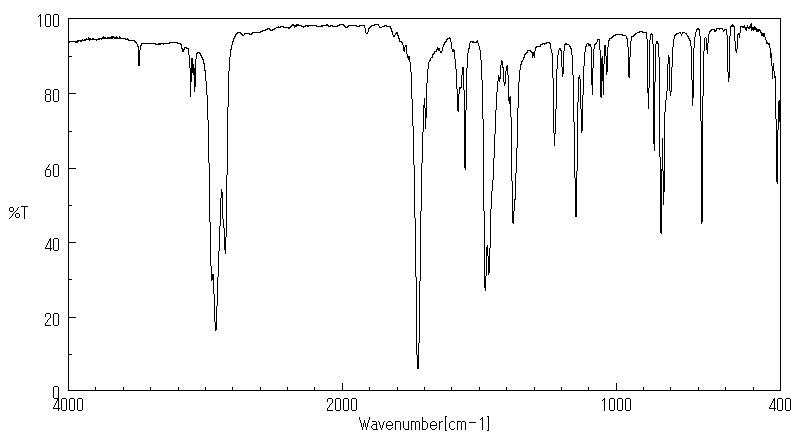N-(2,4,6-三氯苯基)马来酰亚胺 | 13167-25-4
中文名称
N-(2,4,6-三氯苯基)马来酰亚胺
中文别名
1-(2,4,6-三氯苯基)-1H-吡咯-2,5-二酮;N-(2,4,6-三氯苯)马来酰亚胺
英文名称
N-(2,4,6-trichlorophenyl)maleimide
英文别名
1-(2,4,6-Trichlorophenyl)-1H-pyrrole-2,5-dione;1-(2,4,6-trichlorophenyl)pyrrole-2,5-dione
CAS
13167-25-4
化学式
C10H4Cl3NO2
mdl
MFCD06797173
分子量
276.506
InChiKey
VHZJMAJCUAWIHV-UHFFFAOYSA-N
BEILSTEIN
——
EINECS
——
-
物化性质
-
计算性质
-
ADMET
-
安全信息
-
SDS
-
制备方法与用途
-
上下游信息
-
文献信息
-
表征谱图
-
同类化合物
-
相关功能分类
-
相关结构分类
物化性质
-
熔点:134 °C
计算性质
-
辛醇/水分配系数(LogP):2.9
-
重原子数:16
-
可旋转键数:1
-
环数:2.0
-
sp3杂化的碳原子比例:0.0
-
拓扑面积:37.4
-
氢给体数:0
-
氢受体数:2
安全信息
-
危险类别码:R36/37/38
-
海关编码:2925190090
-
安全说明:S36/37/39
-
储存条件:室温
SDS
N-(2,4,6-三氯苯基)马来酰亚胺 修改号码:5
模块 1. 化学品
产品名称: N-(2,4,6-Trichlorophenyl)maleimide
修改号码: 5
模块 2. 危险性概述
GHS分类
物理性危害 未分类
健康危害
皮肤腐蚀/刺激 第2级
严重损伤/刺激眼睛 2A类
环境危害 未分类
GHS标签元素
图标或危害标志
信号词 警告
危险描述 造成皮肤刺激
造成严重眼刺激
防范说明
[预防] 处理后要彻底清洗双手。
穿戴防护手套/护目镜/防护面具。
[急救措施] 眼睛接触:用水小心清洗几分钟。如果方便,易操作,摘除隐形眼镜。继续冲洗。
眼睛接触:求医/就诊
皮肤接触:用大量肥皂和水轻轻洗。
若皮肤刺激:求医/就诊。
脱掉被污染的衣物,清洗后方可重新使用。
模块 3. 成分/组成信息
单一物质/混和物 单一物质
化学名(中文名): N-(2,4,6-三氯苯基)马来酰亚胺
百分比: >98.0%(LC)
CAS编码: 13167-25-4
分子式: C10H4Cl3NO2
N-(2,4,6-三氯苯基)马来酰亚胺 修改号码:5
模块 4. 急救措施
吸入: 将受害者移到新鲜空气处,保持呼吸通畅,休息。若感不适请求医/就诊。
皮肤接触: 立即去除/脱掉所有被污染的衣物。用大量肥皂和水轻轻洗。
若皮肤刺激或发生皮疹:求医/就诊。
眼睛接触: 用水小心清洗几分钟。如果方便,易操作,摘除隐形眼镜。继续清洗。
如果眼睛刺激:求医/就诊。
食入: 若感不适,求医/就诊。漱口。
紧急救助者的防护: 救援者需要穿戴个人防护用品,比如橡胶手套和气密性护目镜。
模块 5. 消防措施
合适的灭火剂: 干粉,泡沫,雾状水,二氧化碳
特殊危险性: 小心,燃烧或高温下可能分解产生毒烟。
特定方法: 从上风处灭火,根据周围环境选择合适的灭火方法。
非相关人员应该撤离至安全地方。
周围一旦着火:如果安全,移去可移动容器。
消防员的特殊防护用具: 灭火时,一定要穿戴个人防护用品。
模块 6. 泄漏应急处理
个人防护措施,防护用具, 使用个人防护用品。远离溢出物/泄露处并处在上风处。
紧急措施: 泄露区应该用安全带等圈起来,控制非相关人员进入。
环保措施: 防止进入下水道。
控制和清洗的方法和材料: 清扫收集粉尘,封入密闭容器。注意切勿分散。附着物或收集物应该立即根据合适的
法律法规处置。
模块 7. 操作处置与储存
处理
技术措施: 在通风良好处进行处理。穿戴合适的防护用具。防止粉尘扩散。处理后彻底清洗双手
和脸。
注意事项: 如果粉尘或浮质产生,使用局部排气。
操作处置注意事项: 避免接触皮肤、眼睛和衣物。
贮存
储存条件: 保持容器密闭。存放于凉爽、阴暗处。
远离不相容的材料比如氧化剂存放。
包装材料: 依据法律。
模块 8. 接触控制和个体防护
工程控制: 尽可能安装封闭体系或局部排风系统,操作人员切勿直接接触。同时安装淋浴器和洗
眼器。
个人防护用品
呼吸系统防护: 防尘面具。依据当地和政府法规。
手部防护: 防护手套。
眼睛防护: 安全防护镜。如果情况需要,佩戴面具。
皮肤和身体防护: 防护服。如果情况需要,穿戴防护靴。
模块 9. 理化特性
固体
外形(20°C):
外观: 晶体-粉末
颜色: 白色类白色
气味: 无资料
N-(2,4,6-三氯苯基)马来酰亚胺 修改号码:5
模块 9. 理化特性
pH: 无数据资料
熔点:
134°C
沸点/沸程 无资料
闪点: 无资料
爆炸特性
爆炸下限: 无资料
爆炸上限: 无资料
密度: 无资料
溶解度:
[水] 无资料
[其他溶剂] 无资料
模块 10. 稳定性和反应性
化学稳定性: 一般情况下稳定。
危险反应的可能性: 未报道特殊反应性。
须避免接触的物质 氧化剂
危险的分解产物: 一氧化碳, 二氧化碳, 氮氧化物 (NOx), 氯化氢
模块 11. 毒理学信息
急性毒性: 无资料
对皮肤腐蚀或刺激: 无资料
对眼睛严重损害或刺激: 无资料
生殖细胞变异原性: 无资料
致癌性:
IARC = 无资料
NTP = 无资料
生殖毒性: 无资料
模块 12. 生态学信息
生态毒性:
鱼类: 无资料
甲壳类: 无资料
藻类: 无资料
残留性 / 降解性: 无资料
潜在生物累积 (BCF): 无资料
土壤中移动性
log水分配系数: 无资料
土壤吸收系数 (Koc): 无资料
亨利定律 无资料
constaNT(PaM3/mol):
模块 13. 废弃处置
如果可能,回收处理。请咨询当地管理部门。建议在可燃溶剂中溶解混合,在装有后燃和洗涤装置的化学焚烧炉中
焚烧。废弃处置时请遵守国家、地区和当地的所有法规。
模块 14. 运输信息
联合国分类: 与联合国分类标准不一致
UN编号: 未列明
N-(2,4,6-三氯苯基)马来酰亚胺 修改号码:5
模块 15. 法规信息
《危险化学品安全管理条例》(2002年1月26日国务院发布,2011年2月16日修订): 针对危险化学品的安全使用、
生产、储存、运输、装卸等方面均作了相应的规定。
模块16 - 其他信息
N/A
模块 1. 化学品
产品名称: N-(2,4,6-Trichlorophenyl)maleimide
修改号码: 5
模块 2. 危险性概述
GHS分类
物理性危害 未分类
健康危害
皮肤腐蚀/刺激 第2级
严重损伤/刺激眼睛 2A类
环境危害 未分类
GHS标签元素
图标或危害标志
信号词 警告
危险描述 造成皮肤刺激
造成严重眼刺激
防范说明
[预防] 处理后要彻底清洗双手。
穿戴防护手套/护目镜/防护面具。
[急救措施] 眼睛接触:用水小心清洗几分钟。如果方便,易操作,摘除隐形眼镜。继续冲洗。
眼睛接触:求医/就诊
皮肤接触:用大量肥皂和水轻轻洗。
若皮肤刺激:求医/就诊。
脱掉被污染的衣物,清洗后方可重新使用。
模块 3. 成分/组成信息
单一物质/混和物 单一物质
化学名(中文名): N-(2,4,6-三氯苯基)马来酰亚胺
百分比: >98.0%(LC)
CAS编码: 13167-25-4
分子式: C10H4Cl3NO2
N-(2,4,6-三氯苯基)马来酰亚胺 修改号码:5
模块 4. 急救措施
吸入: 将受害者移到新鲜空气处,保持呼吸通畅,休息。若感不适请求医/就诊。
皮肤接触: 立即去除/脱掉所有被污染的衣物。用大量肥皂和水轻轻洗。
若皮肤刺激或发生皮疹:求医/就诊。
眼睛接触: 用水小心清洗几分钟。如果方便,易操作,摘除隐形眼镜。继续清洗。
如果眼睛刺激:求医/就诊。
食入: 若感不适,求医/就诊。漱口。
紧急救助者的防护: 救援者需要穿戴个人防护用品,比如橡胶手套和气密性护目镜。
模块 5. 消防措施
合适的灭火剂: 干粉,泡沫,雾状水,二氧化碳
特殊危险性: 小心,燃烧或高温下可能分解产生毒烟。
特定方法: 从上风处灭火,根据周围环境选择合适的灭火方法。
非相关人员应该撤离至安全地方。
周围一旦着火:如果安全,移去可移动容器。
消防员的特殊防护用具: 灭火时,一定要穿戴个人防护用品。
模块 6. 泄漏应急处理
个人防护措施,防护用具, 使用个人防护用品。远离溢出物/泄露处并处在上风处。
紧急措施: 泄露区应该用安全带等圈起来,控制非相关人员进入。
环保措施: 防止进入下水道。
控制和清洗的方法和材料: 清扫收集粉尘,封入密闭容器。注意切勿分散。附着物或收集物应该立即根据合适的
法律法规处置。
模块 7. 操作处置与储存
处理
技术措施: 在通风良好处进行处理。穿戴合适的防护用具。防止粉尘扩散。处理后彻底清洗双手
和脸。
注意事项: 如果粉尘或浮质产生,使用局部排气。
操作处置注意事项: 避免接触皮肤、眼睛和衣物。
贮存
储存条件: 保持容器密闭。存放于凉爽、阴暗处。
远离不相容的材料比如氧化剂存放。
包装材料: 依据法律。
模块 8. 接触控制和个体防护
工程控制: 尽可能安装封闭体系或局部排风系统,操作人员切勿直接接触。同时安装淋浴器和洗
眼器。
个人防护用品
呼吸系统防护: 防尘面具。依据当地和政府法规。
手部防护: 防护手套。
眼睛防护: 安全防护镜。如果情况需要,佩戴面具。
皮肤和身体防护: 防护服。如果情况需要,穿戴防护靴。
模块 9. 理化特性
固体
外形(20°C):
外观: 晶体-粉末
颜色: 白色类白色
气味: 无资料
N-(2,4,6-三氯苯基)马来酰亚胺 修改号码:5
模块 9. 理化特性
pH: 无数据资料
熔点:
134°C
沸点/沸程 无资料
闪点: 无资料
爆炸特性
爆炸下限: 无资料
爆炸上限: 无资料
密度: 无资料
溶解度:
[水] 无资料
[其他溶剂] 无资料
模块 10. 稳定性和反应性
化学稳定性: 一般情况下稳定。
危险反应的可能性: 未报道特殊反应性。
须避免接触的物质 氧化剂
危险的分解产物: 一氧化碳, 二氧化碳, 氮氧化物 (NOx), 氯化氢
模块 11. 毒理学信息
急性毒性: 无资料
对皮肤腐蚀或刺激: 无资料
对眼睛严重损害或刺激: 无资料
生殖细胞变异原性: 无资料
致癌性:
IARC = 无资料
NTP = 无资料
生殖毒性: 无资料
模块 12. 生态学信息
生态毒性:
鱼类: 无资料
甲壳类: 无资料
藻类: 无资料
残留性 / 降解性: 无资料
潜在生物累积 (BCF): 无资料
土壤中移动性
log水分配系数: 无资料
土壤吸收系数 (Koc): 无资料
亨利定律 无资料
constaNT(PaM3/mol):
模块 13. 废弃处置
如果可能,回收处理。请咨询当地管理部门。建议在可燃溶剂中溶解混合,在装有后燃和洗涤装置的化学焚烧炉中
焚烧。废弃处置时请遵守国家、地区和当地的所有法规。
模块 14. 运输信息
联合国分类: 与联合国分类标准不一致
UN编号: 未列明
N-(2,4,6-三氯苯基)马来酰亚胺 修改号码:5
模块 15. 法规信息
《危险化学品安全管理条例》(2002年1月26日国务院发布,2011年2月16日修订): 针对危险化学品的安全使用、
生产、储存、运输、装卸等方面均作了相应的规定。
模块16 - 其他信息
N/A
上下游信息
-
上游原料
中文名称 英文名称 CAS号 化学式 分子量 —— N-(2,4,6-trichlorophenyl)maleamic acid —— C10H6Cl3NO3 294.522
反应信息
-
作为反应物:描述:N-(2,4,6-三氯苯基)马来酰亚胺 、 3-甲基-2-丁烯醛 在 苯甲酸 、 L-脯氨酸 作用下, 以 甲苯 为溶剂, 以76%的产率得到5-methyl-2-(2,4,6-trichlorophenyl)isoindoline-1,3-dione参考文献:名称:利用两个亲二烯体的Diels-Alder反应有机催化合成高官能度邻苯二甲酰亚胺摘要:通过α,β-不饱和醛的两个亲二烯体和马来酰亚胺的1-脯氨酸催化的反应,开发了一种有效且简便的合成生物学和药学上重要的邻苯二甲酰亚胺的方案。该反应涉及有效的苯环化,该苯环化是通过从烯醛和N-取代的马来酰亚胺就地生成的氮杂二烯中间体的正式[4 + 2]环加成反应进行的。该协议提供了多种功能化的邻苯二甲酰亚胺衍生物,包括有效的COX-2酶抑制剂。DOI:10.1021/acs.joc.0c01991
-
作为产物:描述:N-(2,4,6-trichlorophenyl)maleamic acid 在 sodium acetate 、 乙酸酐 、 对苯二酚 作用下, 反应 2.0h, 以95%的产率得到N-(2,4,6-三氯苯基)马来酰亚胺参考文献:名称:一种提高N-(2,4,6-三氯苯基)马来酰亚胺收率的合成方法摘要:本发明公开了一种提高N‑(2,4,6‑三氯苯基)马来酰亚胺收率的合成方法,首先在常温下合成N‑(2,4,6‑三氯苯基)马来酰胺酸中间产物,然后中间产物催化脱水得到N‑(2,4,6‑三氯苯基)马来酰亚胺。本发明反应温度低,工业化成本小,危害小,产率可达95%。公开号:CN105949105A
文献信息
-
N-Primary-amine tetrapeptide-catalyzed highly asymmetric Michael addition of aliphatic aldehydes to maleimides作者:Zhi-Hong Du、Wen-Juan Qin、Bao-Xiu Tao、Meng Yuan、Chao-Shan DaDOI:10.1039/d0ob01457e日期:——highly asymmetric Michael addition reaction between maleimides and aliphatic aldehydes catalyzed by low-loading β-turn tetrapeptides with excellent yields and enantioselectivities at room temperature was reported. α-Branched and α-unbranched aldehydes both are suitable nucleophiles. N-Aryl, alkyl and hydrogen maleimides all are well tolerated and led to high yields and enantioselectivities. The transformation
-
Iron‐Catalyzed, Iminyl Radical‐Triggered Cascade 1,5‐Hydrogen Atom Transfer/(5+2) or (5+1) Annulation: Oxime as a Five‐Atom Assembling Unit作者:Wu Liang、Kun Jiang、Fei Du、Jie Yang、Li Shuai、Qin Ouyang、Ying‐Chun Chen、Ye WeiDOI:10.1002/anie.202007825日期:2020.10.19of iminyl radical‐triggered 1,5‐hydrogen atom transfer and (5+2) or (5+1) annulation processes, a series of structurally novel and interesting azepine and spiro‐tetrahydropyridine derivatives have been successfully prepared in moderate to good yields. This method utilizes FeCl2 as the catalyst and readily available oximes as five‐atom units, while showcasing broad substrate scope and good functional
-
Heterocylic fluoroalkenyl thioethers and the use thereof as pesticides (IV)申请人:——公开号:US20030187259A1公开(公告)日:2003-10-02The present invention relates to novel heterocyclic fluoroalkenyl thioethers of the formula (I) 1 in which m represents integers from 3 to 10, n represents 0, 1 or 2 and Het represents the following, in each case optionally substituted, groupings: 2 and to processes for their preparation and to their use as pesticides.
-
Use of riboflavin and flavin derivatives as chitinase inhibitors
-
Synthesis of N-halogenated phenyl maleimide compounds with tin申请人:Atlantic Richfield Company公开号:US04705866A1公开(公告)日:1987-11-10A process for the preparation of N-brominated or N-chlorinated phenylmaleimide by reacting maleic anhydride and a brominated or chlorinated aniline compound at temperatures of from about 100.degree. C. to about 210.degree. C. in the presence of tin containing catalyst compound and optionally an inert solvent.
表征谱图
-
氢谱1HNMR
-
质谱MS
-
碳谱13CNMR
-
红外IR
-
拉曼Raman
-
峰位数据
-
峰位匹配
-
表征信息
同类化合物
颜料红254
颜料橙73
颜料橙 71
赛拉霉素
裂假丝菌素
苯磺酰胺,4-[(2,5-二氢-4-羟基-2-羰基-1,5-二苯基-1H-吡咯-3-基)偶氮]-
苯扎托品氢溴酸盐
苯乙醇,2-(甲氧基甲基)-(9CI)
肼甲硫代酰胺,2-(2,5-二氢-5-羰基-1,2-二苯基-1H-吡咯-3-基)-N-(苯基甲基)-
细交链孢菌酮酸
禾大壮
甲基4-甲酰基-2,3-二氢-1H-吡咯-1-羧酸酯
甲基4-甲氧基-2,5-二氧代-2,5-二氢-1H-吡咯-3-羧酸酯
甲基3-乙烯基-2,5-二氢-1H-吡咯-1-羧酸酯
甲基3,4-二溴-2,5-二氧代-2H-吡咯-1(5H)-羧酸叔丁酯
甲基2-甲基-4,5-二氢-1H-吡咯-3-羧酸酯
甲基2-氮杂双环[3.2.0]庚-3,6-二烯-2-羧酸酯
甲基1-甲基-2,5-二氢-1H-吡咯-3-羧酸酯
甲基(3R)-3-羟基-3,4-二氢-2H-吡咯-5-羧酸酯
烯丙基2,3-二氢-1H-吡咯-1-羧酸酯
氯化烯丙基(3-氯-2-羟基丙基)二甲基铵
氨基甲酰基-2,2,5,5-四甲基-3-吡咯啉-1-氧基
氟酰亚胺
异丙基3,4-二氢-2H-吡咯-5-羧酸酯
己二酸,聚合1,3-二异氰酸基甲基苯,1,2-乙二醇,甲基噁丙环并,噁丙环和1,2-丙二醇
四琥珀酰亚胺金(3+)钾盐
四丁基铵琥珀酰亚胺
吡啶氧杂胺
吡啶,2-[4-(4-氟苯基)-3,4-二氢-2H-吡咯-5-基]-
吡咯烷-2,4-二酮
吡咯布洛芬
叔丁基4-溴-2-氧代-2,5-二氢-1H-吡咯-1-甲酸叔丁酯
叔丁基1H,2H,3H,4H,5H,6H-吡咯并[3,4-C]吡咯-2-甲酸酯盐酸盐
叔-丁基4-(4-氯苯基)-2-氧亚基-2,5-二氢-1H-吡咯-1-甲酸基酯
利收
假白榄内酰胺
二氯马来酸的N-(间甲基苯基)酰亚胺
二-硫代-二(N-苯基马来酰亚胺)
乙基4-羟基-1-[(4-甲氧苯基)甲基]-5-羰基-2-(3-吡啶基)-2H-吡咯-3-羧酸酯
乙基4,5-二氢-1H-吡咯-3-羧酸酯
乙基2-氧代-3,4-二氢-2H-吡咯-5-羧酸酯
乙基2-乙氧基-2-羟基-5-氧代-2,5-二氢-1H-吡咯-1-羧酸酯
乙基2,5-二氢-1H-吡咯-3-羧酸酯
乙基1-苄基-4-羟基-5-氧代-2,5-二氢-1H-吡咯-3-羧酸酯
β.-核-六吡喃糖,1,6-脱水-2-O-(2-氰基苯基)甲基-3-脱氧-4-O-甲基-
[4-(2,5-二氧代吡咯-1-基)苯基]乙酸酯
[3-乙酰基-2-(4-氟-苯基)-4-羟基-5-氧代-2,5-二氢-吡咯-1-基]-乙酸
[3-(甲氧羰基)-2,2,5,5-四甲基-2,5-二氢-1H-吡咯-1-基]氧氮自由基
[3,4-二(溴甲基)-2,2,5,5-四甲基-2,5-二氢-1H-吡咯-1-基]氧氮自由基
[(2R)-1-乙酰基-2,5-二氢-1H-吡咯-2-基]乙腈










